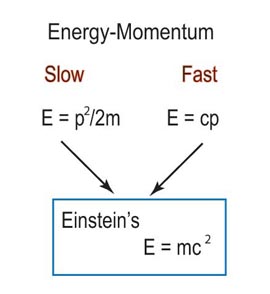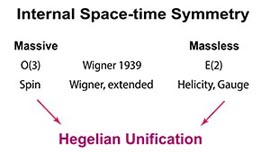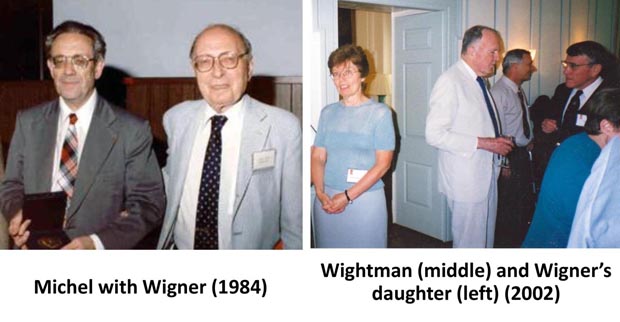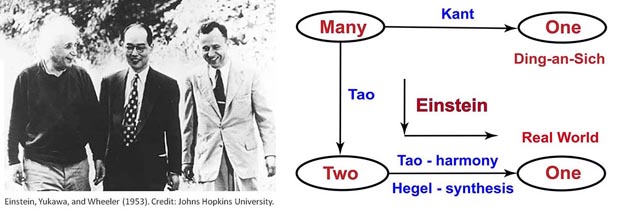Feynman and Hegel
Georg Wilhelm Friedrich Hegel was a German philosopher whose books are very difficult to read. He was very active during the 19th Century. Feynman was born 100 years ago in 1918. He was a neat-looking American physicist always talking in a straight-forward manner, often with cartoons and diagrams. It is agreed that he was the best American-born physicist.
- Why should these two historical figures be mentioned in a single
webpage? The answer is very simple. They need each other.
We are accustomed to Feynman's language. On the other hand, it is
impossible to make sense out of Hegel's writings, partly because of
his scary image:
- Fortunately
Bertland Russel translated Hegel's ideas into the language for
physicists. Like Feynman, Russel often used diagrams to illustrate the
ideas.
In order to illustrate Hegel's dialectic process, Russel used the diagram

in his book entitled Wisdom of the West. This is an excellent philosophy book for children.
You may also be interested in the video: Lecture on Hegel.
- Why does Hegel need Feynman? We can answer this question by saying that
Hegel needs physics, especially the history of physics.
Click here for an explanation. You will note
there that the history of physics consists of Hegel's dialectic processes.
However, philosophers will not be able to understand this webpage. They are
smart people, but they could not do mathematics.
- It is well known that Einstein was an enthusiastic Kantinist when he was a high-school
student. He later became a Hegelianist while formulating the energy-momentum
relation applicable to both massive particles and massless particles.
- We all love and respect Feynman. He once said
the adventure of our science of physics is a perpetual attempt to recognize that the different aspects of nature are really different aspects of the same thing.
Here he sounds like a Kantianist. One thing (Ding-an-Sich) looks differently for different observers depending on their environments and states of mind. Click here for a story.
This young man respects Feynman. Yet, he did not know he wanted to become a Hegelianist. He realized that quantum mechanics of scattering states and bound states could be different, yet he made no attempts to hegelianize them. He also noted his parton picture appears different from Gell-Mann's quark model. He did not make any attempts to hegelianize them.
|
Why is Hegel so strange to physicists?
I did some research along this direction primarily for personal reasons. I received my PhD degree in 1961, but did not become an independent thinker until 1965. Since then, I have been at odd with the physics establishment in the United States. I spent many years to find out what is wrong with me. My trouble has been and still may be that I am a Hegelianist, while there is a thick barrier between Hegel and the profession of physics.
- In 1966, I almost got fired from my position by publishing an article
not friendly to Princeton's Institute for Advanced Study.
Click here for a story.
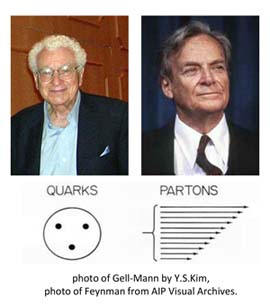
We need another Hegelian process to combine these two phenomena into one Lorentz-covariant theory. - In 1977, with Marilyn Noz, I published
this paper in the Physical Review telling Feynman's parton model and Gell-Mann's
quark model are two limiting cases of one Lorentz-covariant entity. Since then,
I became totally isolated from the community of high-energy physics. That is why I
had to turn to the Wigner business.
- In his 1939 paper, Eugene Wigner found out the internal space-time symmetry for
a massive particle at rest if like the three-dimensional rotation group. This
is how the particle spin is defined. For a massless particle, the symmetry is
like E(2) or the two-dimensional Euclidean group with one rotational degree of
freedom and two translational degrees of freedom. It is very easy to associate
the rotational degree with the helicity
of the particle. However, the issue of its translational degree of freedom
was not completely understood until 1987.
Click here for a story.
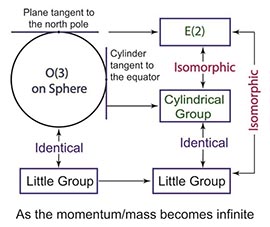
- In 1979,
I started writing papers on Wignerism.
In 1983, with D. Han and D. Son, I published a paper
telling that Wigner's two different little groups are two limiting cases of
one Lorentz-covariant quantity, just like the case of the quark-parton problem.
However, these papers made many of my colleagues unhappy, and my position was again in jeopardy. The best way to solve this problem was to talk to Wigner directly and published papers with him, and I did.
This made me think deeply about why my way of thinking was so different from other people. I then noted that Einstein was not able to talk with American physicists, and I started tracing Einstein's philosophical background. It was not difficult to find out that Einstein started as a Kantianist, but ended up with a Hegelinainit, as shown in this figure:
 Click here for a published
article on this subject.
Click here for a published
article on this subject.

Kant's grave in Kalinigrad. 
Click here to enlarge this image. - My research effort along this direction started with a visit to
Kaliningrad (German city of
Koenigsberg until 1945) to study how Kant developed his philosophy. This city
maintains a Kant museum.
I also visited
Stuttgart where Hegel was born and raised. His childhood house
there serves ad a museum called Hegelhaus.
In those museums, there are spaces dedicated to important books written about these two great philosophers.
There are many books displayed at those museums written in many different languages. Alas, there are no books written in English. Even though there are many books in English on Kant and Hegel, the museum curators did not find any of those books important enough. As you know, English is the language for physics these days. There seems to be a language barrier between the physicists and the Kant-Hegel world.
- At the Hegel museum in Stuttgart, nearly one half of the place was
dedicated to political ideologies. The museum explains how Marx and
Lenin got their ideas from Hegel. This aspect of Hegel makes him
a stranger to sane people.

- Yes, Karl Marx is also an important historical figure. He was a
Hegelianist. He noted that there
is a price gap between raw materials and finished products. He
used the word "surplus value" to specify this difference. This surplus
value of became the cost of labor, so essential in the capitalistic
world.
However, Marx made a mistake in getting involved in political ideology. There is a gap between "the haves" and "the have-nots." He wanted to make an ideal world by Hegelianizing these two groups. Marx was among those incompetent politicians in the world.
These days, there are videos telling American two-party system works according to the Hegelian process. I knew this for many years, but I did not want to be the first one to say this.
There is another important point about Karl Marx. Let us see what he says about philosophers.
Marx said this before Einstein was born. He should have said "philosophers only talk about the world, but physicists are the ones who can change the world." In either case, Marx was an important person in the Hegelian school of thought, as noted by Humboldt University.
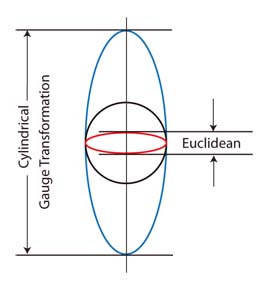
- In 1939, Wigner published a paper on mathematical formulation for
internal space-time symmetries. The point is whether we can extend
Einstein's special relativity inside a particle with space-time extensions.
He noted that massive and massless particles have two distinctive
symmetries. The question is whether we can construct a Hegelian process
to combine both of them into one.
Wigner knew there was a problem, but he did not construct the mathematical mechanism to solve this problem. Wigner liked me because I did this for him.
- However, my collaboration with Wigner made angry two distinguished physicists.
They were Arthur Wightman and Louis Michel. They were known for
their mathematical rigor and professional honesty. Yet, they did everything
to eradicate the result shown in the following table contained in my papers.
Einstein's World Massive/Slow between Massless/Fast Energy
MomentumE=p2/2m Einstein's
E=(m2 + p2)1/2E=p Helicity
Spin,GaugeS3
S1 S2Wigner's
Little GroupHelicity
Gauge Trans. - I was very close to Wightman and Michel. I learned the Wigner stuff from them,
especially the two-by-two representation of the Lorentz group (very useful these
days in quantum optics and information theory). I was close enough to
take the following photos with my camera.
The point is that there are no personal reasons for them to dislike me. They honestly thought I was wrong.
- The only reason why they were so unhappy about my result was that I was a
Hegelianist, while they were not.
I was able to communicate with Wigner because Wigner spent many years in Berlin and gained enough Hegelian background. I once asked him whether he thinks like Kant. He said Yes. I then asked him about Hegel. He said "I like him too." Click here for Wigner's Berlin.

-
Friedrich Nietzsche was also a distinguished German philosopher,
regarded as the originator of Existentialism." He was born in 1844 and
died in 1900. He had talents in many different directions except m
athematics. He of course studied Kant and Hegel in depth. He then
concluded that Kant was an oriental philosopher. The word "oriental"
at his time meant "useless" or "crackpot." Things are somewhat
different these days. In either way, what Nietzsche said about Kant
is true.
It is well known that Einstein was a Kantianist. Thus, according to Nietzsche, Einstein was an oriental philosopher. Among the distinguished physicists of the 20th Century, Hediki Yukawa was an oriental philosopher capable of reading the original Taoist books written 2,500 years ago. Let us look at the following photo.
Einstein is very happy with Yukawa in this photo. It is possible that they talked about the oriental philosophy, and Einstein found out where he stands among the philosophers.
- copyright@2018 by Y. S. Kim, unless otherwise specified.
- Click here for his
home page.
- Einstein page.
- Princeton page.
- He liked to tell you stories.
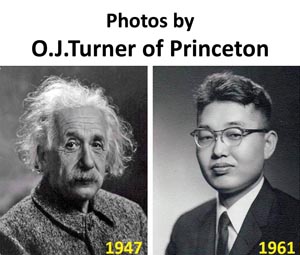
| |
|


